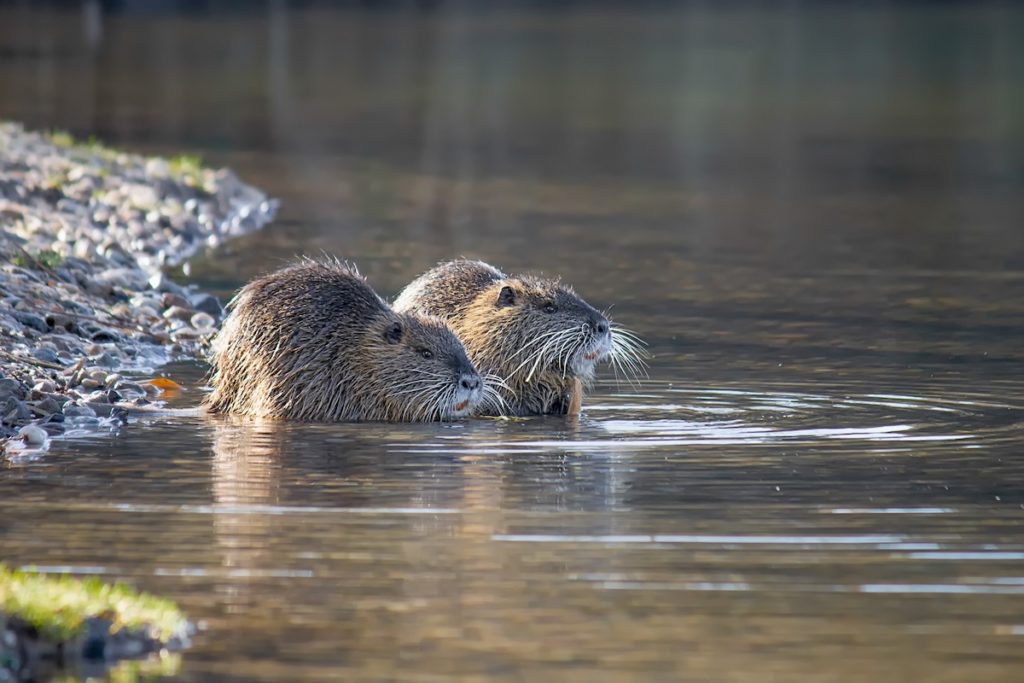
Sergii Koviarov from Pixabay-nutria7089358
Nutria (Myocastor coypus) are native to South America and are considered an invasive species in the United States.
They were brought to the U.S. in the late 1800s by fur farmers looking to raise them for their (then) valuable pelts. The animals escaped or were turned loose as the fur market declined in the 1940s. Some of the escaped nutria survived and thrived, establishing populations and spreading across the south and into the northeast U.S.
Negative impacts caused by nutria range from compromising levees when they dig their burrows, damaging crops, and ecological disruptions caused by excessive removal of native plants in wetland systems. Nutria can also carry diseases including tuberculosis and septicemia as well as parasites including various flukes, tapeworms and nematodes.
If you have recently seen a nutria, please REPORT the sighting to the Illinois Department of Natural Resources. Due to the similarities of nutria to beaver and muskrats, the IDNR is not collecting information on nutria sightings that cannot be verified.
Learn more about nutria in Illinois in OutdoorIllinois Journal:
Nutria are dark-colored, semi-aquatic rodents that resemble muskrats and small beavers. There are several characteristics can be used to differentiate between the three species.
Nutria are larger than muskrats but smaller than beavers, and their backs are more arched. Additionally, nutria have white muzzles and long, white whiskers, while muskrats and beavers have black whiskers.
The tails are another distinguishing feature. Nutria have long, round tails that may become shortened due to frostbite during cold Illinois winters. In comparison, beavers have broad, paddle-like tails and muskrats have thin, laterally flattened tails. When in the water, muskrats move their tails in a snake-like fashion as they swim, whereas nutria drag their heavy, rat-like tails behind them while swimming.
Average Length: 36 to 42 inches including the tail
Average Weight: 15 to 20 pounds
| Characteristics | Nutria | Beaver | Muskrat |
| Tail | Heavy, round and rat-like | Broad and paddle-like | Laterally flattened |
| Weight | 15-20 pounds | 25-60 pounds | 1.5-4 pounds |
| Body Length | 24 inches | 31-41 inches | 10-14 inches |
| Tail Length | 12-18 inches | 10-20 inches | 8-11 inches |
| Whiskers | white | black | black |
| Lodging | Platform of dead vegetation or burrow | Lodge of mud and sticks | Mounded hut of mud and vegetation |
Nutria tracks can reach up to 6 inches long. They have 5 toes per foot and have webbing on the hindfeet.
Nutria primarily eat vegetation but will also consume invertebrates such as mussels and snails. They are skilled at digging and readily excavate burrows and build platforms for feeding and nesting. While nutria are generally nocturnal, they can be observed early and late in the day.
Nutria breed throughout the year and can have up to 3 litters per year, averaging 4-6 young. There are few native predators large enough to take down adult nutria, allowing populations to grow rapidly. Population status is currently unknown in Illinois since so few animals have been verified.
Negative impacts caused by nutria range from compromising levees when they dig their burrows, to crop damage, and ecological disruptions caused by excessive removal of native plants in wetland systems.
Nutria are native to South American and were brought to the United States in the late 1800s by fur farmers. Escaped and released animals survived and spread across the southern U.S. and the northeast U.S. Nutria have been documented moving up the Mississippi River Valley and are found in Missouri, Arkansas,Tennessee and Kentucky. To date, there are no coordinated eradication efforts reported from these states, but most have opened their trapping seasons to include nutria during the regular beaver, muskrat, and otter seasons.
Anecdotal reports of nutria have been received from various locations in southern Illinois since the early 2000s. Despite multiple reports from credible sources, documentation corroborating these reports was limited.
The IDNR is working with researchers from Southern Illinois University-Carbondale (SIUC) to identify and sample priority habitats in southern Illinois. Work includes:
Nutria removal efforts in Illinois will need to be a coordinated effort. It will also be necessary to assess the impacts that nutria have on wetland ecology, agriculture, and infrastructure. The IDNR is working with USDA Wildlife Services to assess and remove nutria populations where found in Illinois. Additionally, the IDNR encourages private landowners and wildlife-related non-profit organizations and agencies (i.e., The Nature Conservancy, American Land Conservancy, U.S. Fish and Wildlife Service, etc.) to trap and remove nutria on properties that they own and manage.
Nutria are not protected by the Illinois Wildlife Code and are considered an invasive species in Illinois. They may be removed without a permit.
Please submit a sighting report here of nutria that have been trapped or found (e.g., roadkilled nutria). Due to the similarities of nutria to beaver and muskrats, the IDNR is not collecting information on nutria sightings that cannot be verified.

USFWS National Digital Library

The Wildlife Illinois website was authorized by the Illinois Department of Natural Resources (IDNR) in partial fulfillment of project W-147-T. The website was developed by the National Great Rivers Research and Education Center, 2wav, and the IDNR in partnership with the United States Department of Agriculture Animal and Plant Health Inspection Service Wildlife Services and University of Illinois Extension to provide research-based information about how to coexist with Illinois wildlife.